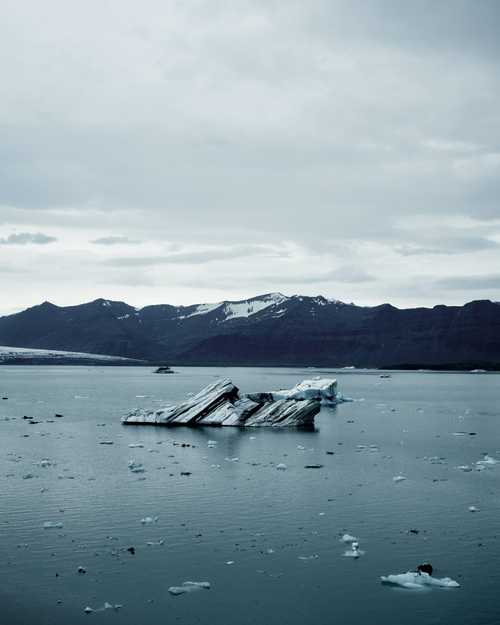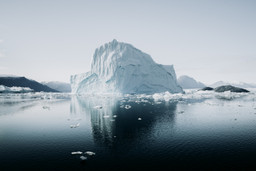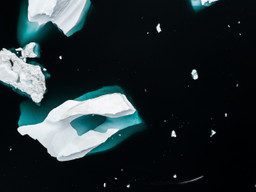
The sounds of ice and why we should be listening
What does ice sound like? For those of us whose experience of the substance is limited to the occasional wintry frozen puddle, we may imagine that ice is inert and voiceless. But, on the contrary, a Spotify playlist accompanying New York Times article ‘The Poignant Music of Melting Ice’ quickly demonstrates otherwise.
These otherworldly soundscapes are compared in the piece to the likes of Autechre and Aphex Twin, but the playlist’s eight tracks – existing as they do outside of the structures (and strictures) of western music – outdo such electronic music in their densely layered, alien complexity. The inexorable movement of glaciers, the gushing of meltwater, and the violence of Antarctic blizzards are the sources of “vertiginous drone[s]”, “allegro[s] of snaps and pops”, “plangent rumble[s]”, and “fusillades of tiny pops from escaping air”.
The diverse figures profiled by the Times, all of whom have made work with recordings of ice – researcher Grant Deane, artist Mia Feuer, composer-producer Thomas Köner, sound artist and researcher Philip Samartzis, artist and filmmaker Susan Schuppli, glaciologist Martin Sharp, and musicians Eliza Bożek and Jana Winderen – hope that such recordings could play a twofold role in combating the climate crisis. Firstly, the sounds of “melting ice, splintering glaciers and cascading runoff” have a practical function: the monitoring and prediction of rates of climate change and sea-level increases.
If more people can actually hear climate change through the once-unknown songs of failing ice, can they be inspired to help prevent it?
The second, more lateral application could be the ability of music created from these sounds to prompt listeners to question their attitudes toward the natural world. By bringing tangible immediacy to concepts like rising sea level, which may seem abstract or out of sight and out of mind, such work may connect audiences to these issues in ways that headlines and statistics may not: “If more people can actually hear climate change through the once-unknown songs of failing ice, can they be inspired to help prevent it?”
Winderen, for example, describes the “presence” a glacier’s gliding movement generates when heard via hydrophone: “like a [living] creature”. Processed from raw recordings into aural collages, her music “unfurl[s] as tone poems, […] [creating] a spiritual gravitas”; “poignant emotional postcards from masses of melting and cracking masses of ice”. As Samartzis adds, “[Though] these recordings may not be scientifically sound, […] it’s a whole other way of communicating knowledge.”
BBC report ‘Thwaites: ‘Doomsday Glacier’ Vulnerability Seen in New Maps’ demonstrates why this is a subject which we should be paying attention to, by outlining the significance of glacier loss. The Antarctic Thwaites Glacier is melting at such an accelerated pace that it is releasing around 88 billion tons (80 billion tonnes) of ice into the ocean annually, pushing up global sea-levels. The glacier is currently restrained by a floating ice shelf; however, this is predicted to collapse within a decade from 2021. This event will cause a significant increase to the outflow from Thwaites – meltwater from which “is already responsible for about 4% of global sea level rise”. This “would become equivalent to 5% in the short term, and likely accelerate further in the longer term”. Regardless of the actual timespan, glaciologist Robert DeConto makes it clear that, once melted, “marine-based ice is not going to come back”.

Were the entirety of the Thwaites Glacier to collapse, it alone would be responsible for an increase to global sea levels of more than 25 inches (65cm). Though this is unlikely to occur in the (ominously nonspecific) “short-to-medium term”, Thwaites is especially vulnerable due to “a network of deep channels [underneath it, which] […] are the potential pathways for deep-ocean warm water to get in and do damage”.
Glaciers around the globe have been melting rapidly since 1900, due to the elevation of atmospheric temperatures by increasing greenhouse gas emissions since the Industrial Revolution. This is significant because the bright whiteness of ice-cover cools the Earth by reflecting heat back into space. Glacial ice covers around 10% of land on the planet – 90% of which is in Antarctica, and 10% in the Greenland ice cap. As climate change causes this ice to melt, not only do sea levels rise, but the “massive amounts of very cold glacial-melt water entering warmer ocean waters” slows ocean currents. Ice loss also exposes areas of the darker ocean below, which absorbs rather than reflects heat, “creating warmer air temperatures and in turn disrupting normal patterns of ocean circulation”. Antarctic and Greenlandic glacier loss, specifically, “is changing the circulation of the Atlantic Ocean and has been linked to collapse of fisheries in the Gulf of Maine and more destructive storms and hurricanes around the planet”.
The sea level rises caused by glacier loss additionally drive coastal erosion and the increased incidence of coastal storms such as hurricanes and typhoons, due to warming air and ocean temperatures. This in turn drives storm surge – “an abnormal rise of water generated by a storm, over and above the predicted astronomical tides”.
In addition, the melting of glaciers is particularly significant since, while it remains frozen, this water is contained on land; the melting of floating sea ice does not affect sea levels to the same degree. This is not to suggest that the loss of sea ice does not have dramatic consequences. On the contrary: the loss of Arctic sea ice in particular “triggers a host of other devastating consequences—from depleting available ice on which walrus can haul out or polar bears hunt to changing weather systems around the world by altering the pattern of the Jet stream”.
Cumulatively, these effects are significant for the entire planet. Continued increases in ocean temperatures and the melting of sea ice and glaciers will alter “regional hydrology” (the movement, distribution, and management of water), and further disrupt ocean currents and weather patterns. Fisheries will be affected; coastal communities will “face billion-dollar disaster recovery bills as flooding becomes more frequent and storms become more intense”; polar wildlife will lose its habitats.

Glacier loss and sea level rise is just one consequence of the devastating onslaught which human activity continues to level against the stability of the natural world. However, using sound recording to study the climate crisis “has boomed in recent years” – from monitoring the health of coral reefs to investigating “how the relationship between pairs of yellow-breasted boubou in Nigeria and Cameroon changes with the weather and climate, to the impact of aircraft noise on protected forests in France”.
In the world of glaciology, sound recording “is advancing what we know about the forces inside a glacier as it melts”; recordings of the tiny vibrations made by breaking ice can “help predict future changes in mass loss in Greenland and Antarctica, […] [and] can be used for assessing glacial hazards”.
University of Oslo researcher Ugo Nanni has made recordings of Kongsvegen Glacier in Svalbard with a seismometer, their frequencies adjusted into audiability. When we listen to these science-fictional ambiences – staticky crunches, gunshot-like snaps, fizzing hisses – we are brought into contact not only with a methodology for countering Anthropocenic change, but with a manifestation of nature that typically remains out of earshot. But will the ability to give voice to an imperiled world mean that we really take in its message?
🎧 Listen to ice on earth.fm:
Featured photo by Hans Hamann on Unsplash
Earth.fm is a completely free streaming service of 1000+ nature sounds from around the world, offering natural soundscapes and guided meditations for people who wish to listen to nature, relax, and become more connected. Launched in 2022, Earth.fm is a non-profit and a 1% for the Planet Environmental Partner.
Check out our recordings of nature ambience from sound recordists and artists spanning the globe, our thematic playlists of immersive soundscapes and our Wind Is the Original Radio podcast.
You can join the Earth.fm family by signing up for our newsletter of weekly inspiration for your precious ears, or become a member to enjoy the extra Earth.fm features and goodies and support us on our mission.
Subscription fees contribute to growing our library of authentic nature sounds, research into topics like noise pollution and the connection between nature and mental wellbeing, as well as funding grants that support emerging nature sound recordists from underprivileged communities.

